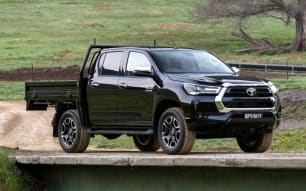Given its cosy cabin feel, the SR5 is surprisingly accommodating for tall drivers like me, particularly our ‘plus’ version with its heated and eight-way power-adjustable leather-accented driver’s seat. Combined with the height/reach adjustable steering wheel and large left footrest, it’s easy to find a comfortable driving position.
HiLux unladen ride quality has always been on the firm side and it can become quite jiggly over bumps, corrugations and other road irregularities. The hydraulic power-assisted steering has a noticeably different feel to the more common electro-mechanical systems, being slightly heavier and more linear in its weight changes between parking and highway speeds.
The engine can be a bit noisy higher up the rpm range, but it’s not overly intrusive and there’s no need to rev it hard anyway. With maximum torque between 1600-2800rpm, most driving tasks can best be achieved within those numbers given that there’s a healthy 500Nm on offer. Highway cruising produces low tyre and wind noise, along with minimal engine noise given that 110km/h can be maintained with less than 2000rpm.
To test its heavy load-hauling ability we loaded 770kg into the load tub, which combined with our crew of two equalled a total payload of around 930kg that just snuck in under the 940kg threshold.
The rear leaf springs compressed 60mm, which still left around 40mm of bump-stop clearance that was more than ample in ensuring there was no bottoming-out during our GVM test.
As we’ve discovered during previous weight-testing of HiLux utes, the ride quality noticeably improves when carrying the one-tonne payloads they’re primarily designed for. The big increase in sprung weight creates a smoother and more cushioned ride that irons out all but the largest bumps.
The SR5+ also easily cleared our 13 per cent gradient 2.0km-long set climb at 60km/h. It self-shifted down to fourth gear and 2250rpm, where it tapped maximum torque to efficiently haul this load to the summit.
Engine-braking on the way down wasn’t as strong. In a manually-selected second gear, there wasn’t enough retardation on overrun to stop the tachometer needle spinning as high as 4250rpm (soft redline 4400rpm) before I had to push the middle pedal. Fortunately, the front disc/rear drum brakes were effective in keeping us within the posted 60km/h speed limit.

